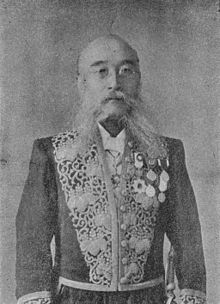Chisaka Takamasa
Chisaka Takamasa ( Japanese : 千 坂 高雅 ; born March 11, 1841 in Yonezawa , Yamagata prefecture ; † December 3, 1912 ) was an administrative officer, businessman and politician in the Japanese Empire , the governor of various prefectures and chief secretary of the Ministry of Internal Affairs ( Naimu- shō ) was. Between 1894 and his death in 1912 he was also a member of the manor house ( Kizokuin ) , the upper house of the Reichstag (Teikoku-gikai) .
Life
Chisaka Takamasa was the eldest son of the samurai Takaaki Chisaka , a follower of the Yonezawa clan. He was a follower of the Supreme Leader ( Daimyō ) of the Yonezawa clan, Uesugi Narinori from the Uesugi clan, and took part in the Boshin War in Echigo Province between 1868 and 1869 , where he was involved in combat operations for the Military Alliance Ōuetsu Reppan Dōmei the province of Echigo, the province of Dewa and later in Shinjō , Akita and Niigata was used. After the return of the Han register (Hanseki-hōkan) he himself became a leading member (dai-sanji) of the Yonezawa clan in 1870 and accompanied the new Supreme Leader of the Yonezawa clan, Uesugi Mochinori , on his study trip to England . After his return to Japan in 1873 he became an employee of Interior Minister Ōkubo Toshimichi in the newly established Ministry of Internal Affairs ( Naimu-shō ) . There he was responsible for the implementation of the land tax reform (chisokaisei) , which, however, met with resistance. During the Satsuma rebellion he was a lieutenant colonel next to Yamakawa Hiroshi from the Han Aizu, commander of the military units in Ibaraki Prefecture .
On February 24, 1879, Chisaka became governor of Ishikawa Prefecture and held this post until he was replaced by Iwamura Takatoshi on January 19, 1883. He himself then became chief secretary of the Ministry of the Interior between January 1883 and December 1884 and succeeded on December 22, 1884 Takasaki Goro as governor of Okayama Prefecture . He held this office for almost ten years until September 19, 1894, after which Kōno Chūzō became his successor. During his tenure as governor of Okayama the businessman Fujita Denzaburō was given the approval of remedial measures in the Bay of Kōjima, which led to years of rejection in the population. In 1886 the Notre Dame Seishin College, a college for women run by the School Sisters of Notre Dame of Namur , was founded in Okayama . Before that, the girls' school there, which Fukuda Hideko co-founded in 1882, was closed in 1884 . After retiring from the administration, he became a member of the manor house ( Kizokuin ) , the upper house of the Reichstag (Teikoku-gikai) on September 19, 1894 , and was a member of this until his death on December 3, 1912.
He also worked in the private sector and served among others as Manager of the Ryou-Bank (Ryou Ginko) , the hydroelectric power plant at Ujigawa and the department store company of Yokohama (Yokohama Warehouce Co., Ltd.) . After his death he was buried at the Ikegami Honmon-ji Buddhist temple in Tokyo's Ōta district . His son Chisaka Tomojirō was Vice Admiral in the Imperial Japanese Navy .
Web links
- Chisaka Takamasa in Portraits of Modern Japanese Historical Figures
| personal data | |
|---|---|
| SURNAME | Chisaka, Takamasa |
| ALTERNATIVE NAMES | 千 坂 高雅 (Japanese) |
| BRIEF DESCRIPTION | Japanese officer, governor, manager and politician |
| DATE OF BIRTH | March 11, 1841 |
| PLACE OF BIRTH | Yonezawa , Yamagata Prefecture , Japanese Empire |
| DATE OF DEATH | December 3, 1912 |
